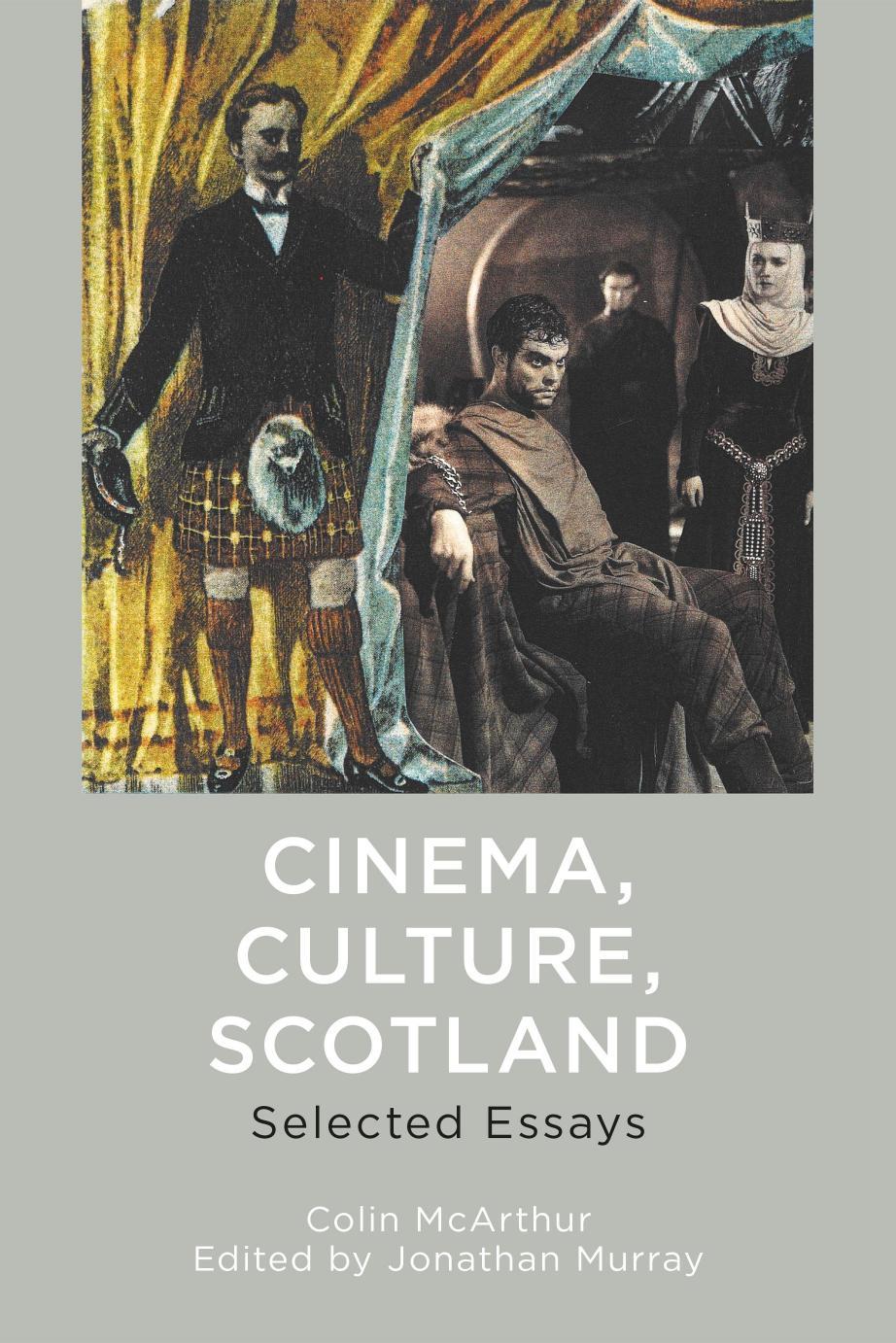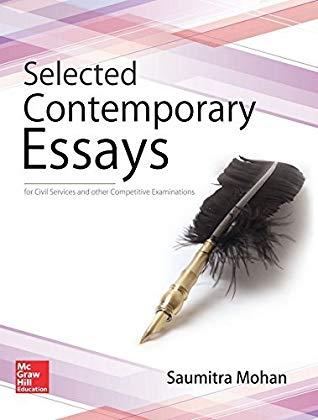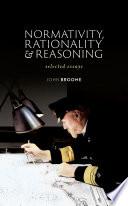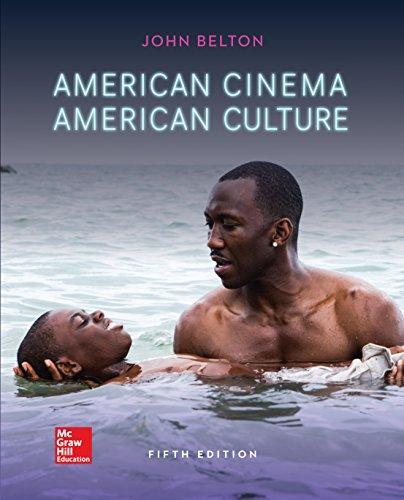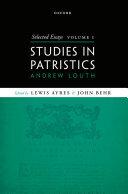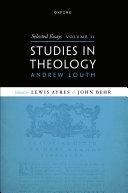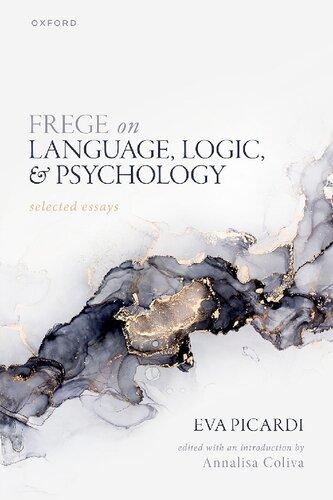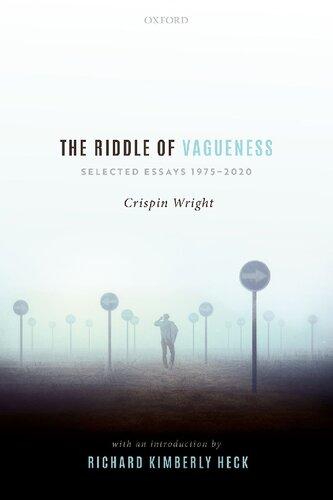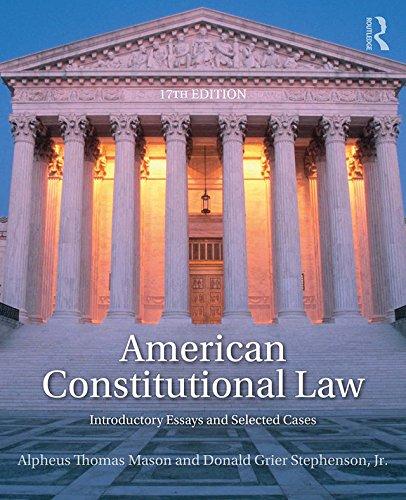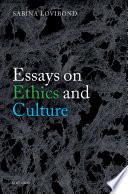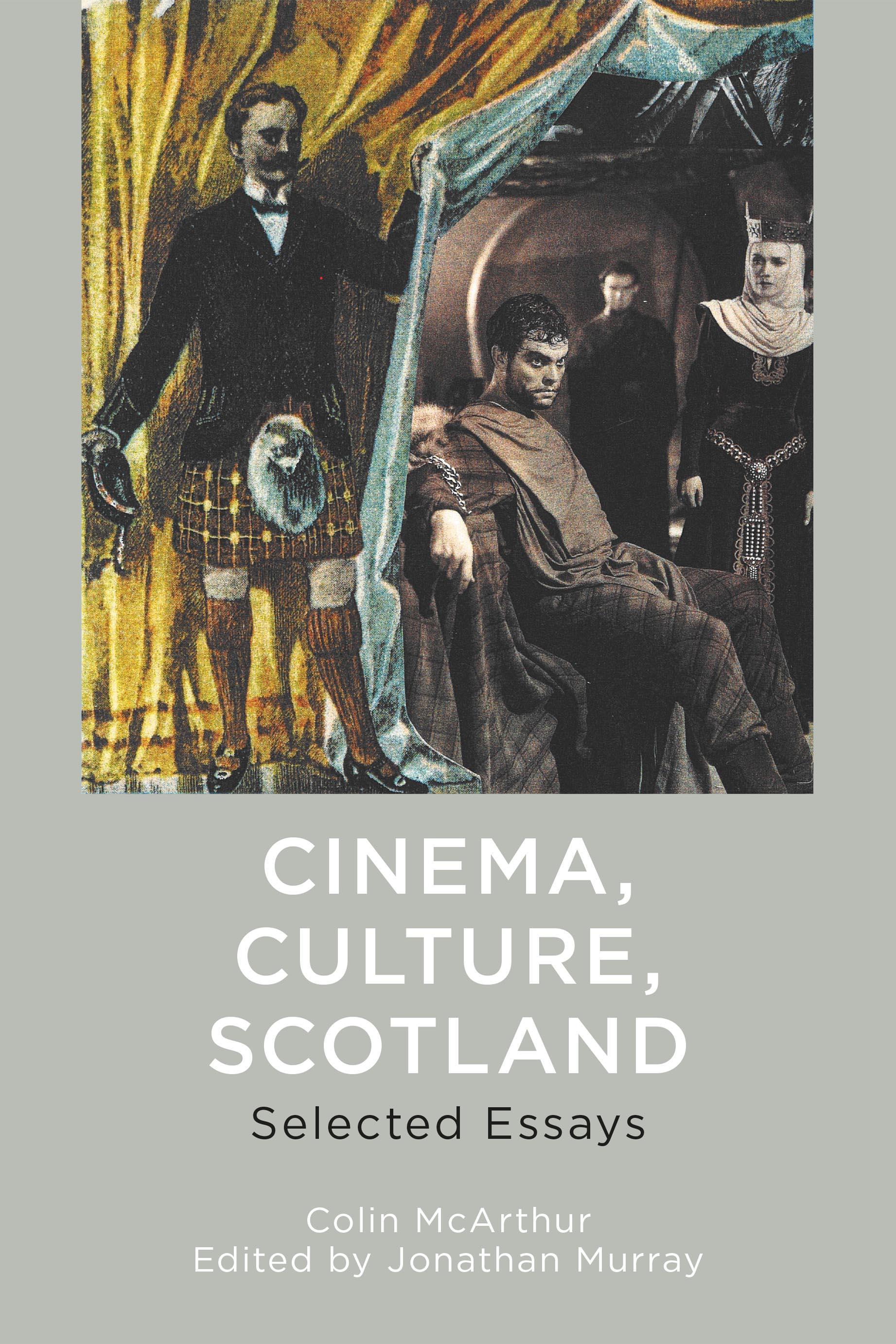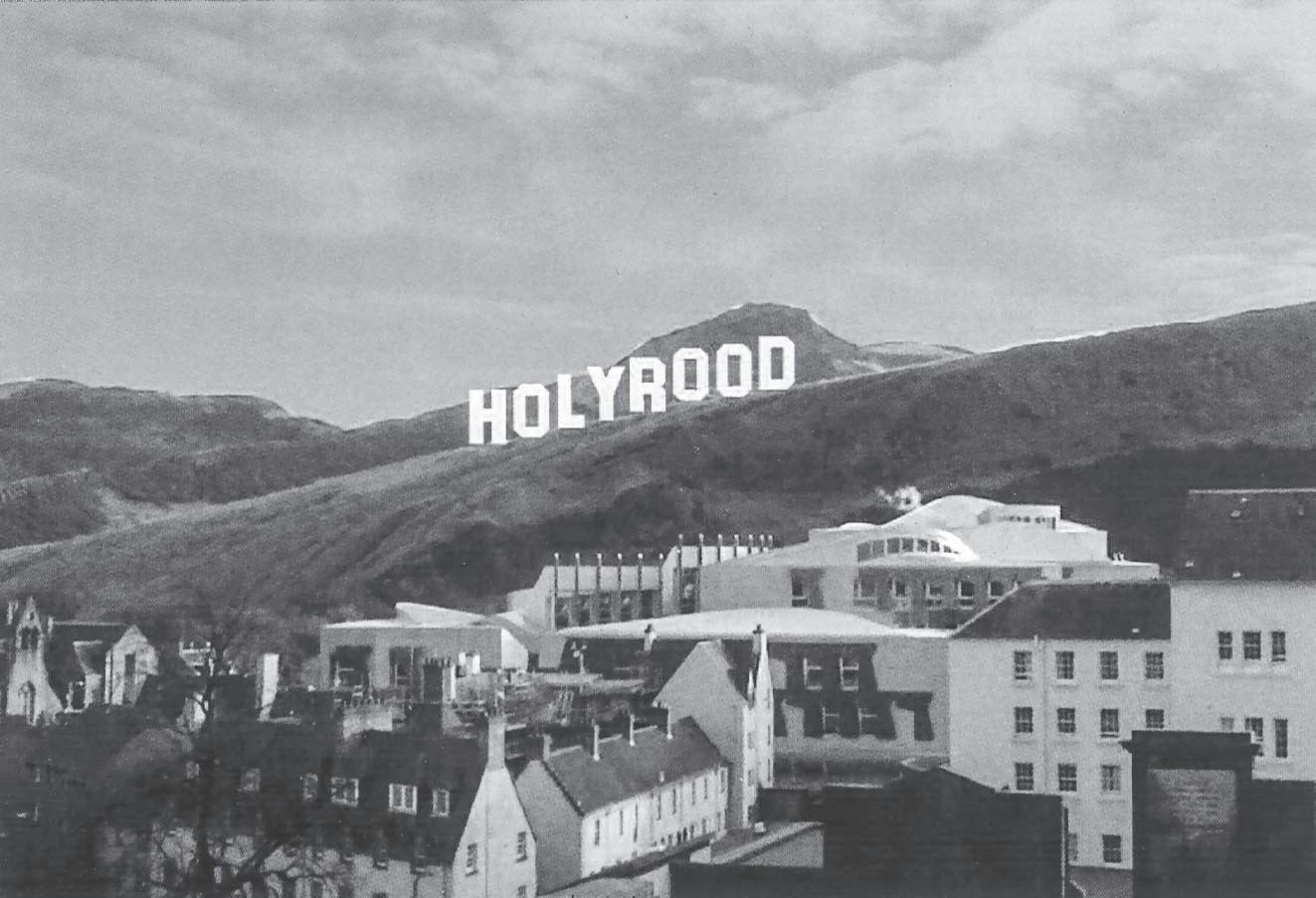Cinema, Culture, Scotland
Selected Essays
Colin McArthur and Jonathan Murray
Edinburgh University Press is one of the leading university presses in the UK. We publish academic books and journals in our selected subject areas across the humanities and social sciences, combining cutting-edge scholarship with high editorial and production values to produce academic works of lasting importance. For more information visit our website: edinburghuniversitypress.com
© Colin McArthur and Jonathan Murray, 2024 Cover image: collage by Colin McArthur Cover design: www.richardbudddesign.co.uk
Grateful acknowledgement is made to the sources listed in the List of Illustrations for permission to reproduce material previously published elsewhere. Every effort has been made to trace the copyright holders, but if any have been inadvertently overlooked, the publisher will be pleased to make the necessary arrangements at the first opportunity.
Edinburgh University Press Ltd
The Tun – Holyrood Road 12(2f) Jackson’s Entry Edinburgh EH8 8PJ
Typeset in 11/13 Monotype Ehrhardt by IDSUK (DataConnection) Ltd, and printed and bound in Great Britain
A CIP record for this book is available from the British Library
ISBN 978 1 3995 1286 2 (hardback)
ISBN 978 1 3995 1288 6 (webready PDF)
ISBN 978 1 3995 1289 3 (epub)
The right of Colin McArthur and Jonathan Murray to be identified as the author of this work has been asserted in accordance with the Copyright, Designs and Patents Act 1988, and the Copyright and Related Rights Regulations 2003 (SI No. 2498).
7.
8.
15.
16.
17.
18.
19.
20.
21.
26. Artists and Philistines: The Irish and Scottish Film Milieux 317
27. Braveheart and the Scottish Aesthetic Dementia 331
28. The Exquisite Corpse of Rab(elais) C(opernicus) Nesbitt 349
29. Mise-en-scène Degree Zero: Jean-Pierre Melville’s Le Samouraï 371
30. The Critics Who Knew Too Little: Hitchcock and the Absent Class Paradigm 385
31. Caledonianising Macbeth, or, How Scottish is ‘The Scottish Play’? 403
32. Two Steps Forward, One Step Back: Cultural Struggle in the British Film Institute 427
33. Transatlantic Scots, Their Interlocutors and the Scottish Discursive Unconscious 449
34. Scotch Myths, Scottish Film Culture and the Suppression of Ludic Modernism 469
35. Bring Furrit the Tartan-Necks! Nationalist Intellectuals and Scottish Popular Culture 487
36. Vanished or Banished? Murray Grigor as Absent Scots Auteur 503 Author’s Afterword: Colin McArthur 513 Select Bibliography 523
Figures and Tables
Figures
Frontispiece: Scotland meets Hollywood. This collage encapsulates two central themes of the book: Scottish culture and Hollywood cinema. Artist: Murray Grigor. ii
1.1 Maciek, having shot Szczuka, catches his falling body in a ‘filial’ embrace 31
2.1–2 Agrarianism versus Industrialism. The wagon train divides and the ‘holy plow’ is discarded 42
3.1 Nationalism in the mise-en-scène. Skip’s final confrontation with Joey shot against a recruiting poster for the US Army 46
4.1 Recurrent trope of the genre: the gangster lies dead in the street in Odds Against Tomorrow 60
4.2 The influence of the Kefauver Committee on the gangster film: Hoodlum Empire; the character of Senator Stephens (centre) in the ‘Kefauver’ role 65
6.1 The opening image of Crossfire: an anti-Semite murders a Jew. Film noir or ‘social problem’ film? 79
7.1 From ‘Here be dragons’ to the picturesque: from the late eighteenth century on, the Scottish Highland landscape became a fit subject for artists and tourists 88
7.2 Cynicus deconstructs the iconic Scottish symbol and motto 92
8.1 Italy absorbs the Scottish Discursive Unconscious: 7 pistole per i MacGregor 98
8.2–3 The River Clyde functions in two discourses within Floodtide: the Scotland of beautiful hills and lochs and the Scotland of bustling industry 105
9.1–2 Sheena, the Spirit of Scotland, advances with open arms and leads Marshall into the dance 130
14.1 Scotland as Janus. Past and future as the modernist Tate tower looms over the Clachan 167
17.1 Contrary to popular belief, whisky’s historical advertising did not always contain representations of Scotland or Scots 198
18.1 Unlike the dominant discourse about Glencoe, this collage evokes laughter rather than tears. Artist: Murray Grigor 214
22.1 Poster advertising an exhibition of the authorial photomontages included in the original version of this essay. The photomontage reproduced here is entitled ‘Imagined Community’ 251
23.1 The design of this fiftieth-anniversary poster reflects the marginalisation of the Second World War in modern accounts of Casablanca 274
25.1 City versus Country in The Barkleys of Broadway. Fred Astaire and Ginger Rogers drag Oscar Levant for a weekend in the country 293
27.1 Romanticism and Caspar David Friedrich in Braveheart: Wallace atop a mountain 335
28.1 ‘Ich bin ein sheep-shagger!’ Rab C. Nesbitt’s Cotter moved to tears on hearing ‘Flower of Scotland’, expresses solidarity with Highland Scots 363
29.1–2 Jean-Pierre Melville’s Cinema of Process: Jef, stealing a car, searches for a compatible ignition key in Le Samouraï 380
33.1 The Scottish Discursive Unconscious 453
33.2 1950s Scots-Americans wholly enmeshed in the Scottish Discursive Unconscious 459
34.1 Scotland meets Hollywood once again: Murray Grigor directs Sam Fuller in Scotch Myths 473
Tables
9.1 Celt/Anglo-Saxon 126
13.1 Homo Oeconomicus/Homo Celticus 152
14.1 Core/Periphery 161
18.1 English/Scottish 208
21.1 Homo Oeconomicus/Homo Celticus 240
24.1 Homo Oeconomicus/Homo Celticus 282
25.1 City Girl/Country Girl 292
25.2 Metropolis/Small Town 293
25.3 City-Cape Cod/Midwest Town 295
Editor’s Introduction
Jonathan Murray
Cinema, Culture, Scotland: Selected Essays anthologises thirty-seven scholarly essays written by Colin McArthur between 1966 and 2022. Organised chronologically, containing works published in all decades between the 1960s and 2020s, and including twenty-one essays hitherto out-ofprint and a new authorial afterword, the book identifies and illustrates the central strands of critical enquiry and approach animating one of British Film Studies’ and Scottish Cultural Studies’ most pioneering, prolific and polemic careers. McArthur’s multifaceted interests and achievements include: his role in legitimising the analysis of Classical Hollywood genre cinema within Anglophone Film Studies; his leadership, inspirational and controversial in equal parts, in establishing Scotland’s cinematic representation as an accepted and widely practiced object of study; and his imaginative and informed interrogation of Scotland’s distinctive identity and presence as a visual and material cultural signifier within a diverse range of domestic and international popular cultural traditions from the eighteenth century until the present. As well as showcasing an important individual contribution to the disciplines of Film Studies and Scottish Cultural Studies, therefore, collecting these essays together also illuminates key aspects of those disciplines’ respective post-1960 histories and trajectories.1 Many of the following essays contain new authorial and editorial annotation that aims to illustrate and explain the ways in and extent to which this is so.
McArthur’s publishing career incorporates numerous monographs, edited anthologies, print journalism, scholarly book chapters and academic journal articles. Because they have until now represented perhaps the most logistically dispersed and least practicably accessible areas of his oeuvre, this volume focuses (with four exceptions) exclusively on the latter two categories.2 The exceptions to that editorial rule are as follows. An extended extract from McArthur’s 1972 monograph Underworld U.S.A. is presented to underscore his significance as a pioneering Anglophone
historian and theorist of Classical Hollywood cinema and to illustrate a transitional moment in early-1970s Anglophone Film Studies where auteurist theoretical approaches of the previous decade came into initial contact with structuralist and semiological counterparts that shaped the discipline’s evolution during the 1970s. A transcript of a 1988 invited lecture, ‘The New Scottish Cinema?’ makes that work generally available for the first time and provides a useful snapshot of McArthur’s thinking at the end of a decade during which his better-known published works on Scottish cinema history and theory comprehensively transformed academic awareness of and approaches to that subject. Finally, two examples of McArthur’s journalistic practice, ‘In Praise of a Poor Cinema’ and ‘Wake for a Glasgow Culture Hero’ (both from 1993), illustrate not only its characteristic literary style and critical approach, but also its importance as a vehicle through which he has regularly rehearsed and disseminated the critical arguments and approaches defining his scholarly oeuvre. The various works presented here constitute a comprehensive illustration of McArthur’s critical identity and influence and, hopefully, an invitation to also discover or revisit the substantial body of his writings not collected within these pages. The following editorial introduction briefly introduces each of the thirty-seven essays which are included here. Although Polish cinema would not become a long-term concern within McArthur’s writing,3 ‘Ashes and Diamonds’ (1966), an extended narrative and formal analysis of Andrzej Wajda (1926–2016)’s 1958 film of that name, usefully flags the existence of several critical and political preoccupations that did: most centrally, the moving image’s status as an influential vehicle through which images of and ideas about national identities and histories emerge and circulate, both locally and globally. This early essay is also suggestive in displaying McArthur’s career-long close attention to questions of cinematic form: if he aims to establish the nature of Ashes and Diamonds’s ‘central politico-social statement’, he simultaneously asserts that Wajda’s ‘superb technique’4 is in large part the vehicle that creates, then communicates the former. While many of his later, better-known writings explore wide-ranging theoretical, methodological and institutional questions, McArthur has regularly undertaken extended formal analyses of particular moving image artists and texts that he deems of especial cultural and political significance and that broadly follow the critical model already sketched out in this early essay. Examples of that critical approach in the present volume include: ‘Crossfire and the Anglo-American Critical Tradition’ (1977); ‘The Maggie’ (1983); and ‘Mise-en-scène Degree Zero: Jean-Pierre Melville’s Le Samourai’ (2000).
‘The Roots of the Western’ (1969) illustrates that the United States and France are perhaps the two nations which figure at most length, alongside his native Scotland, within McArthur’s multi-decade interest in the relationship between the moving image and discourses of national identity. On one hand, and as several of the 1960s and 1970s essays republished here show, McArthur’s early work was one pioneering vehicle through which the emergence and early evolution of Anglophone Film Studies were centrally informed by mid-twentieth-century French theorists such as André Bazin (1918–58) and French publications such as Cahiers du cinéma. 5 But, on the other, such Continental influences were originally applied by McArthur and his peers6 in order to develop path-breaking accounts of a range of Classical Hollywood genres, including the Western, film noir and gangster cycles. In addition, ‘The Roots of the Western’ also illustrates distinctive aspects of McArthur’s individual critical identity within that wider intellectual phenomenon. In McArthur’s case, the late1960s/early-1970s creation of theoretically informed histories of specific American film genres extends out into an extensive exploration of wider American cultural and intellectual eighteenth- to twentieth-century histories. Like several other essays in this volume, ‘The Roots of the Western’ is a work of cultural history as well as film theory.
An extended contextual and formal analysis of the 1953 Samuel Fuller (1912–97) film of the same name, ‘Pickup on South Street’ (1969) is another early instantiation of critical strategies and preoccupations that structure several of this volume’s later essays. These include McArthur’s alreadynoted concern with cinema’s illumination of and intervention within debates around particular national identities at particular historical moments and his firm conviction regarding the aesthetic, historical and ideological significance of ‘low’ (and thus, potentially overlooked) cultural texts, traditions and artists. As one seminal influence on McArthur during his early career framed matters, ‘the struggle between what is good and worthwhile and what is shoddy and debased is not a struggle against the modern forms of communication, but a struggle within those media’.7 Or, as McArthur puts it in a 2001 essay that looks back on the late-1960s British Film Studies milieu within which ‘Pickup on South Street’ was written, ‘to promote discussion of authorship and genre centred on popular Hollywood cinema was to us as much a political as an aesthetic act’.8 On one hand, McArthur’s argument that ‘Pickup is [. . .] a political film in the sense that it emanates from its author’s intense nationalism and connects with the recurrent theme in Fuller’s work of the demands of nationality’9 explains his critical interest, as an assiduous student of cinema’s relationship with national identity discourses, in this film and filmmaker. On the other
hand, however, it also exemplifies certain structuring terms within a wider contemporaneous turn within British Film Studies towards recuperation and re-evaluation of popular film traditions and artists, most especially, ones associated with Classical Hollywood.10 McArthur concludes that ‘the connection between the bleak underworld of Pickup and the political structure of [the film’s] contemporary America [. . .] is not one that Sam Fuller perceives. Because he fails to make the connection, however, is no good reason for undervaluing [. . .] his work.’11 He thus speaks eloquently of the late-1960s British turn towards Hollywood while that turn speaks eloquently through him.
‘Pickup on South Street’ appears like a microcosmic dry run for several elements of one of McArthur’s most significant works: his 1972 monograph, Underworld U.S.A.12 Both are centrally concerned with the mid-twentieth-century Hollywood gangster film, auteurist evaluations of individual directors prominent within that tradition and unapologetic assertion of the intellectual and ideological necessity of studying Classical Hollywood cinema. Yet Underworld U.S.A. also illustrates the developing nature of its author’s critical practice and the embryonic British disciplinary context informing it. The book looks to develop not simply a working history of specific Classical Hollywood genres (film noir, the gangster film), but also elements of a transferable theoretical methodology and rationale for discussing other film genres and the overarching concept of film genre per se: ‘there is a sense’, McArthur argues, ‘in which all Hollywood movies are genre pieces’.13 In this, Underworld U.S.A. offers an early example of ‘auteur-structuralism’, the late-1960s/1970s attempt to combine and reconcile elements of 1960s auteurist critical approaches and the structuralist counterparts that proved prominent throughout the 1970s. For one contemporary reviewer, ‘probably the most significant aspect’ of the book was ‘the overdue recognition by an auteur-orientated critic of the positive influence of genre [. . .] on the work of various filmmakers’, while another similarly welcomed ‘an interesting future for a new mixture of critical approaches, combining generic with authorial groupings’.14 The extracts from Underworld U.S.A. presented here testify not only to McArthur’s status as an important historian of Classical Hollywood;15 they also illustrate elements of the evolving early-1970s milieu of British Film Studies and the long-term importance of structuralist thought within McArthur’s subsequent critical career.
‘Politicising Scottish Film Culture’ (1976) introduces the subject matter for which, alongside his work on Classical Hollywood, McArthur is best known: the interlocking histories of Scotland’s cinematic representation and the belated, late-twentieth-century emergence of an indigenous
Scottish feature cinema. The question McArthur opens this essay with –‘How might Scottish film culture be politicised?’16 – remained pivotal within his remarkable body of Scottish film history and criticism over the next four decades. More generally, ‘Politicising Scottish Film Culture’ also demonstrates the extent to which all of McArthur’s writing on Scotland and the moving image deploys a highly distinctive (and often, critically contentious) admixture of polemic to more standard academic methodologies. The presence of ‘Politicising Scottish Film Culture’ here also highlights important aspects of Scottish cinema history that remain comparatively overlooked within academic scholarship. Despite the recent emergence of significant studies of 1970s British cinema, for example, the history of indigenous Scottish filmmaking pre-1980 remains understudied.17
Before study of Scotland’s relationship with the moving image became a dominant concern within McArthur’s writing, ‘Crossfire and the AngloAmerican Critical Tradition’ (1977) marked a final significant engagement with Classical Hollywood cinema until two early-1990s monographs.18 Taking a 1947 Hollywood film which had been critically discussed primarily as a socially conscious account of post-World War II American antisemitism, the essay instead reads that text as a paradigmatic example of film noir, thus producing a radically different (metaphysically rather than socially focused) re-interpretation of Crossfire. More ambitiously yet, and via the kind of extended close textual analysis that forms an intermittent but consistent strain within his oeuvre, McArthur uses his microcosmic re-reading of Crossfire to make a macrocosmic claim for the intellectual and ideological value of what were by 1977 clearly emergent, politically and theoretically radical methodological approaches (structuralism; semiology) within Anglophone Film Studies. Such approaches, and McArthur’s individual work within them, sought to dismantle and displace an earlier, cross-Atlantic critical consensus which, McArthur argues, was compromised on ideological (‘impatient commitment to liberal humanist values’) and formal (‘faltering grasp of aesthetics’19) grounds alike. For McArthur, systemic misreading of Crossfire – including by some of the personnel who made it – was symptomatic of a much broader, decadeslong critical and popular cultural Anglophone dismissal of Classical Hollywood cinema as a legitimate object of study.20
Although one of this volume’s few pieces not explicitly concerned with the moving image, ‘Breaking the Signs: Scotch Myths as Cultural Struggle’ (1981), a review of a 1981 gallery exhibition of the same name by Barbara Grigor (1944–94) and Murray Grigor, is of clear importance for McArthur’s subsequent Scottish-themed work. Encountering and
evaluating the Grigors’ exhibition provided him with multiple enduring critical interests and tools.21 If the ‘political purpose’ of Scotch Myths ‘was to provoke debate about the representation of Scotland and the Scots’,22 that identified purpose on the part of others was one that McArthur’s own subsequent work on Scottish film and television clearly also adopted. More specifically, the Grigors’ identification of Tartanry and Kailyard as the dominant post-eighteenth-century, cross-media representational discourses within which Scottish identities and histories were constructed and circulated, both locally and globally, proved a key reference point within nearly all of McArthur’s work on Scotland. The cross-media aspect (‘literature, lithography, photography, the postcard, the music hall, films, television’23) of the Grigors’ argument is an especially important influence to note. Several of this volume’s essays either contextualise film and television texts through cross-references to other visual and material cultural traditions (‘Casablanca: Where Have All the Fascists Gone?’; ‘Caledonianising Macbeth, or How Scottish is the Scottish Play?’) or take the latter as central objects of study (‘The Dialectic of National Identity: The Glasgow Empire Exhibition of 1938’; ‘A Dram for All Seasons’).
The central argument of ‘Breaking the Signs’ (‘the traditions of Kailyard and Tartanry have to be exposed and deconstructed and more politically progressive representations of Scotland and Scottish identities constructed, circulated and discussed’24) swiftly found significantly fuller expression in what is probably McArthur’s most cited essay, 1982’s ‘Scotland and Cinema: The Iniquity of the Fathers’. The centrepiece of his edited anthology Scotch Reels: Scotland in Cinema and Television, ‘the most influential critical and cultural analysis’25 of Scotland’s relationship with the moving image, ‘Scotland and Cinema’ is arguably the most important essay of Scottish film criticism written by any author to date. The first systematic critical attempt to construct a comprehensive overview of Scotland’s cinematic representation, McArthur’s discussion ranges from 1920s Hollywood through 1940s and 1950s British cinema to 1960s and 1970s Scottish sponsored documentary filmmaking. McArthur sets out several central positions that structured his subsequent Scottish work: the limited (and for the most part, externally created) range of representational discourses – Tartanry, Kailyard, Clydesidism – within which Scotland’s cinematic image was and is constructed and circulated; the aesthetically and ideologically reactionary politics of Scotland’s central film institutions, past and present; and the compromised nature of indigenous Scottish cinema considered as a whole, the symptomatic product of a historically underdeveloped national film culture that ‘failed to keep a historic appointment with the discourses of Marxism and Modernism’.26 The subject of
ongoing critical re-evaluation and rejection decades on from its original publication, ‘Scotland and Cinema’ remains an essential starting point for students of Scottish cinema, Scotland’s cinematic representation and the post-Scotch Reels evolution of Scottish cinema studies.27
‘The Maggie’ (1983) applies the totalising critical approach of ‘Scotland and Cinema’ to a single film, the celebrated Ealing comedy The Maggie (Alexander Mackendrick, 1954). Also further developing and applying aspects of McArthur’s non-Scottish-themed 1970s work (such as his 1977 essay on Crossfire), this essay’s project is a bifurcated one. A condemnatory ideological reading of Mackendrick’s film (‘the locus classicus of everything that is wrong with Scottish film culture’28) coexists with detailed attention to the surrounding processes of its production and contemporary popular critical reception. The latter aspect reflects McArthur’s position, arrived at several years before ‘The Maggie’ was written, that: ‘the notion of “audience” [in academic Film Studies] ought to include theorized awareness of the social context in which particular films are received and read [. . .] the critical machinery through which responses are [constructed . . .] and their articulation’.29 Thus, while popular processes and cultures of film reviewing constitute significant objects of scholarly enquiry within twenty-first-century Film Studies,30 an underappreciated aspect of the work of McArthur (a practicing film journalist since the late 1960s) is its much earlier perception that ‘no act of (film) criticism is innocent [. . .] a critical project is always being enacted’.31 As a consequence, popular reviews of any given cultural text are themselves cultural texts open to critical review. Thus, extensive analysis of specific instances and general practices of popular film reviewing and related journalistic forms is a central component of not only ‘The Maggie’ but many other of this volume’s essays (see, for example, ‘Culloden: A Pre-emptive Strike’; ‘Braveheart and the Scottish Aesthetic Dementia’).32 The same focus proves equally important within McArthur’s early-2000s monograph on Mackendrick’s two Scottish-themed features. Also central to that book is the idea that individual acts and wider histories of academic film criticism should themselves constitute objects, as well as instruments, of scholarly enquiry. That monograph nuances McArthur’s early-1980s reading of The Maggie by insisting on the formal complexity and excellence of Mackendrick’s directorial practice, albeit still concluding that its ultimate results remain problematic in national-representational terms.33
Three short mid-1980s essays reflect various aspects of McArthur’s priorities during that brief period before Scottish subject matter again became a dominant focus during that decade’s second half. Emerging from a BFI summer school, ‘National Identities’ (1984) suggests the
potential transferability to other national cultural contexts of many of his early Scottish work’s main arguments. The latter include the ‘fundamental instability’34 of all national identities, phenomena that are ideologically contestable and changeable precisely because they are, in the first instance, always ideologically constructed; and the central role of (often ostensibly apolitical) popular cultural media as vessels through which national identities are developed, disseminated and debated. Indeed, ‘National Identities’ exemplifies such transferability by focusing on metropolitan British film and television representations of WWII and reactionary mobilisations of the hegemonic myth of that historical event within the 1982 Falklands War. ‘National Identities’ also provides an early extended acknowledgement on McArthur’s part of the work of political historian and theorist, Tom Nairn (1932–2023). Nairn’s central ideas – both regarding the allegedly atypical post-1707 ideological development of Scotland specifically and the question of how Left cultural theorists ought to engage with (or even mobilise) discourses of cultural and political nationalism more generally – became obviously central reference points within McArthur’s writing from here on.35 Finally, the argument of ‘National Identities’ that ‘TV and film constructions of the generative moments of the past need to be related quite concretely to the diverse struggles of the present’36 represents an important staging point within McArthur’s evolving thought. This position formed, for example, both the critical impetus and basis for his extensive 1990s and early-2000s analyses of Braveheart (Mel Gibson, 1995) as a seminal, but highly problematic, event within Scottish film and wider national cultures.37
Originally written for an anthology discussing the work of French literary theorist Roland Barthes (1915–80), ‘TV Commercials: Moving Statues and Old Movies’ (1984) applies the former’s concept of intertextuality to several mid-1980s British TV commercials, demonstrating how these moving image micro-texts are constructed from, and dialogue with, other aspects and instances of popular culture past and present. ‘Tele-history: The Dragon Has Two Tongues’ (also 1984) provides a celebratory analysis of a contemporary Harlech TV series about Welsh history on account of what McArthur presents as the work’s multiple formal and ideological departures from the historic norms of British television programmes about national history. ‘Scotland’s Story’ (1985) is a sibling piece to ‘Tele-history’, providing as it does a highly critical account of how a contemporaneous and comparable STV series about Scottish history presents itself as radical and forward-looking, while in fact being ensnared by regressive discourses about Scotland due to being driven in significant part by the aim of sales in North American and other diasporic broadcasting markets.
Given their respective subject matters, the mid-1980s quartet of essays described immediately above might be regarded as, to varying degrees, thematic outliers within McArthur’s oeuvre. But they in fact exhibit and suggest various signature aspects of the latter’s importance. All four pieces display, for example, marked sceptical interest in the cultural, economic and ideological prominence, within 1980s British society, of what ‘Telehistory’ terms ‘the recycling and marketing of the past’.38 In participating within 1980s and early-1990s British Film Studies and Cultural Studies’ collective turn towards discussion and theorisation of contemporary ‘Heritage’ cultures,39 these essays demonstrate the ongoing significance of their author’s work as a suggestive historical catalyst and/or symptomatic exemplification of wider evolutionary shifts shaping the British variants of the academic disciplines within which McArthur has worked. A closely related reason for including these essays in this volume is that they constitute the only period – apart, arguably, from a comparably brief one in the midto-late 1970s – within McArthur’s career during which television, rather than cinema, formed his main object of study.40 When assessing the scale of McArthur’s influence over modern Scottish Cultural Studies, it is relevant to note that, a few important individual exceptions aside, study of postWWII Scottish culture has mostly overlooked the significance or impact of television.41 Scottish cinema, in sharp contrast, forms the subject of no fewer than seven monograph-length studies during the twenty-first century’s first two decades alone.42 Such marked disparity suggests the extent to which McArthur’s Scottish work has enabled subsequent scholars of modern Scottish culture, even where their ideas have disagreed (sometimes markedly) with his.
Most of the 1970s and early-to-mid-1980s essays discussed so far in this volume’s introduction are united by a deep interest in diverse processes and methods of history-writing, academic and otherwise. ‘The Dialectic of National Identity: The Glasgow Empire Exhibition of 1938’ (1986) inaugurated an important, closely related sub-strand within McArthur’s work from that date on. That sub-strand comprises detailed case study accounts, informed by extensive primary as well as secondary research, of particular historical events, cultural institutions and longer-term discursive processes, usually (but not always) Scottish-themed. ‘The Dialectic of National Identity’, for example, discusses the 1938 Glasgow Empire Exhibition and its contemporary press construction and representation. McArthur’s career-long, Annales School-influenced conception of history as processual as well as event-driven is reflected in this essay’s location of the 1938 Glasgow Exhibition within a wider European imperial tradition of international exhibitions between the mid-1800s and mid-1900s.
The essay also establishes the internal tension within the 1938 Exhibition between its nostalgic construction of ‘Scotland’ as rural utopia and the event’s more forward-looking economic and industrial ambitions, as expressed in the modernist aesthetic of much of its specially constructed architecture.
‘The New Scottish Cinema?’ (1988) is a transcript of an invited lecture delivered at the Glasgow Film Theatre’s Desperately Seeking Cinema event of May 1988. Explicitly geared towards the needs of a general rather than academic audience, the lecture describes the conditions which attended and determined what McArthur understands to be the most celebrated collective movements in cinema history, such as German Expressionism and Italian Neorealism, bemoans such movements’ relative lack of influence within Scottish film culture past and present, and offers speculative explanations for both such absence and Scotland’s failure to produce an internationally visible, but nationally specific cinematic movement-cum-moment of its own. This hitherto inaccessible work also provides, arguably, McArthur’s most rhetorically distilled and readily accessible summary of how he understands his own film critical formation and identity within the wider British Film Studies field. That identity attempts to cross-pollinate the formalist study of cinematic mise-en-scène associated with the journal Movie (1962–2000) with many of the more theoretically orientated, politically radical methodologies developed within the journal Screen (1969–).43
Two of this book’s earlier essays, ‘Pickup on South Street’ and ‘Scotland and Cinema: The Iniquity of the Fathers’, have their roots in the Edinburgh International Film Festival’s highly distinctive and innovative position within late-1960s to early-1980s Anglophone film culture as a bridgehead between film academic and industrial communities and a sponsor of new academic scholarship. ‘The Rises and Falls of the Edinburgh International Film Festival’ (1990) acknowledges this fact within what was perhaps the first critical attempt to produce an extended historical overview of the Festival.44 Tracing EIFF’s frequently shifting trajectory from its founding in 1947 until 1989, McArthur argues that the institution was most influential at moments (the late 1940s; the early 1970s) when it publicly committed to a clear, and left-of-centre, politics of film culture. Another example of the historical case study sub-strand that ‘The Dialectic of National Identity’ introduced into McArthur’s practice, ‘The Rises and Falls’ arguably also prefigured the escalating centrality, within much of his 1990s and 2000s Scottish-themed work, of an institutional turn that had already been highly visible within his earliest writings in that area. In this, McArthur had possibly reached a similar conclusion to that drawn by John Caughie,
also writing about Scottish film history within the same volume in which ‘The Rises and Falls’ originally appeared: ‘representation’ as practice and concept involves balancing both a ‘figurative sense [. . .] of image and identity’ and an ‘institutional sense [. .] of proportionality, representativeness and participation’.45 Finally, and although it lies mostly beyond this volume’s scope, it is worth noting that McArthur also regularly intervened in Scottish film institutional debates via a range of popular press publications from the mid-1970s onwards.46
Returning to the cross-media interests of an earlier work such as ‘Breaking the Signs’ and applying these within a historical case study of the type that increasingly attracted his attention during subsequent decades, ‘A Dram for All Seasons: The Diverse Identities of Scotch’ (1991) explores the history of mass media advertising of Scotch whisky. Confounding the potential assumption that such advertising will invariably have been cast within hegemonic Scottish representational discourses such as Tartanry and Kailyard, this essay’s extensive discussion of primary visual source materials establishes instead its notable intertextual and ideological diversity. In addition to instances of Tartanry and Kailyard, the primary materials McArthur discusses draw on many other discourses and tropes, including canonical British literary and historical figures, whisky’s evolving class-based connotations and its material and symbolic presence in various international locations. This essay’s central conclusions represent a suggestive response to those sceptical readings of McArthur’s Scottish moving image-themed work which see the latter’s methodology and analysis (‘a desire for clean, discernible categories [. . .] organis[ing] the heterogeneity of representation’47) as overly reductive and inflexible in its privileging of macrocosmic structural-historical traditions of representation over the microcosmic inflections or rejections of those by individual films and filmmakers. Without wishing to dismiss such concerns out of hand, ‘A Dram for All Seasons’ is of interest due to its illustration of the possibility of applying the Scotch Reels ideas and method in nuanced and caveated ways.
‘Scottish Culture: A Reply to David McCrone’ (1993) continues and further confirms the above-noted institutional turn within much of McArthur’s 1990s and 2000s Scottish work. In a dialogic response to the critique of Scotch Reels made by another seminal work of modern Scottish Cultural Studies, the sociologist David McCrone’s 1992 monograph, Understanding Scotland: The Sociology of a Stateless Nation, 48 McArthur distils in advance the governing methodology and rationale for a significant portion of his next decade or so of publication. He does so by calling into (rhetorical) question, ‘the extent to which one can conduct an argument
about Scottish culture without discussing the central arts institutions of that culture’.49 ‘Scottish Culture’ can also be taken to exemplify the institutional turn driving much of McArthur’s post-1990 academic writing in another way, in that the essay understands and discusses modern Scottish Cultural Studies as itself being an institutional formation.50 That institution was one within which McArthur felt his ideas had become increasingly contested by the early 1990s. As a consequence, he occasionally sought to take the contemporary state of Scottish Cultural Studies as a dedicated object of enquiry in itself. One of this volume’s final essays, ‘Bring Furrit the Tartan-Necks! Nationalist Intellectuals and Scottish Popular Culture’ is the most explicit example of this.
McArthur’s sense of his previous work’s evolving status within Scottish Cultural Studies by the early 1990s possibly explains the final main significance of ‘Scottish Culture’ for and within his wider oeuvre. This essay offers the first mention (one reiterated and further developed in subsequent essays) of McArthur’s major retrospective augmentation of the Scotch Reels thesis, namely, his theory of ‘the Scottish Discursive Unconscious’. Attempting to respond to critiques of that thesis which saw it as overly dismissive of the importance of individual creative agency and diversity within Scottish cultural production, McArthur’s provisional formulation of the Scottish Discursive Unconscious’s long-term existence, nature and influence proposes that ‘it might be suggested that we tend to be written by the dominant Scottish narratives [of identity and representation] rather than ourselves writing narratives about Scotland’.51 His most extensive and explicit elaboration of that theory perhaps came within the 1996 essay, ‘The Scottish Discursive Unconscious’. There, McArthur proposes that the phenomenon’s ‘disabling effects’ within Scottish cultural and political life stem from ‘its capacity to cause Scots (and those who make images and narratives of Scotland) to turn their faces away from the modern world and scratch the scabs of the Scottish past’.52
Two 1993–94 essays, ‘In Praise of a Poor Cinema’ and ‘The Cultural Necessity of a Poor Celtic Cinema’, should be read in tandem: the latter develops at greater length within a peer-reviewed academic context ideas the former set out in more polemical form in a specialist film magazine article. While a significant degree of overlap inevitably applies across the two works, both are reproduced here as illustrative evidence of a prominent scholar’s working process in developing and resolving particular critical ideas and positions. Reproducing both also works as a useful indication of an aspect of McArthur’s practice that lies beyond this book’s scope, namely, journalism’s significance, since the late 1960s, as a popular platform through which he has regularly initiated, rehearsed and/or further
disseminated aspects of his academic writing, ‘contriv[ing]’, in the words of one reviewer of a 1982 anthology of McArthur’s 1970s film journalism, ‘to discuss sophisticated and difficult concepts in language [. . .] accessible to any reader’.53 ‘In Praise of a Poor Cinema’ is a polemic traducing of the early-1990s policies of the main Scottish cultural institutions responsible for funding indigenous film production. McArthur bemoans those institutions’ conservative commitment to what he describes as a quasi-Hollywood aesthetic and industrial production model. Against the latter, he argues for a national cinema of micro-budgets and avant-garde aesthetic strategies. A more conventionally academic evolution of ‘In Praise’, ‘The Cultural Necessity of a Poor Celtic Cinema’ elaborates further on McArthur’s working concept of ‘Poor Cinema’: a micro-budget, industrially sustainable and culturally sustaining aesthetic, commercial and ideological model for future feature film production in both Scotland and the other small British and Irish nations. For McArthur, the central film professional and political dilemma facing indigenously-based Celtic filmmakers past and present is that: ‘the more your films are consciously aimed at an international market, the more their conditions of intelligibility will be bound up with regressive discourses about your own culture’.54 He presents ‘Poor Cinema’ as a potential escape route from that bind.55
The short essay ‘Wake for a Glasgow Culture Hero’ (1993) celebrates both A Wake for Bud Neill, Murray Grigor’s 1993 television documentary about the eponymous Glasgow newspaper cartoonist (1911–70), and the vitality and legacy of Neill’s signature creation, the late-1940s/early-1950s cartoon-strip character, Lobey Dosser. Brief though it is, this essay connects to and further highlights many of McArthur’s career-long critical interests, including: his deep interest in, and knowledge of, transnational cultural interactions between twentieth-century Scotland and the United States; his politically informed belief in the academic and cultural importance of ‘low’ cultural forms and traditions; and his assessment of Murray Grigor as one of Scottish film culture’s most significant, but also critically and institutionally neglected, creative figures – the latter theme, for example, is one McArthur returns to within two of this book’s final essays (‘Scotch Myths, Scottish Film Culture and the Suppression of Ludic Modernism’; ‘Vanished or Banished? Murray Grigor as Absent Scots Auteur’).
One of this book’s most ambitious essays in terms of the disciplinary diversity and cumulative scale of its primary and secondary research, ‘Culloden: A Pre-emptive Strike’ (1994) aims ‘to re-historicise sentimental Jacobitism in general and the Culloden memorial in particular’.56 Extrapolating from a wide-ranging survey of numerous post-1746 memorialisations of Culloden as historical event, physical site and evolving ideological
myth, McArthur proposes ‘the inescapable fact that there is no “natural”, essentialist way of describing the events and people of 1745–46; there are only diverse “fictions” which might be constructed around them’.57 This essay’s chosen subject matter, methodology and main conclusions indicate the extent to which McArthur’s Scottish work attempts radical reinterpretations of, and interventions within, modern Scottish history and culture generally, as opposed to modern Scottish film history and culture exclusively. As a result, it is of potential cross-disciplinary interest and relevance. ‘Culloden’, for example, contextualises evolving domestic interpretations of, and attitudes towards, the eponymous historical event within a much wider international history of public memorialising practices and artefacts. As a result, an essay written in the mid-1990s speaks to early-2020s debates around the complex ideological significance of memorial statuary associated with British imperial histories and identities. This volume’s shortest essay, ‘Casablanca: Where Have All the Fascists Gone?’ (1995), suggests the value of including ostensibly ‘minor’ works within an anthologising overview of an individual critic’s practice. Approached literally, this essay summarises the distinctive status of Casablanca (Michael Curtiz, 1942) as one of Classical Hollywood’s most intertextually fecund films. Reiterating his marked interest in ‘low’ visual and material cultural traditions and artefacts, McArthur shows the extent to which Casablanca is quoted and reshaped within contexts that extend far beyond the moving image.58 Seen instead as a symptomatic staging post within its author’s evolving practice, however, ‘Casablanca’ is of note because it starts to rehearse certain positions and preoccupations that went on to shape several of McArthur’s most important 2000s essays. Recalling the position of ‘Scottish Culture: A Reply to David McCrone’ that academic disciplines and their internal debates themselves constitute institutional formations urgently requiring analysis, ‘Casablanca’ argues that ‘over a period of fifty years politics has been evacuated’59 from Casablanca’s popular profile and reception. Elsewhere in his later work, McArthur perceives analogous, but far more broadly applicable, late-twentieth-century repressions of particular politicised approaches to moving image studies (most especially, ones predicated on the importance of socioeconomic class). An essay like ‘The Critics Who Knew Too Little: Hitchcock and the Absent Class Paradigm’ (2000), for example, takes that perception as both its critical impetus and central object of enquiry.
The volume’s longest essay, ‘Chinese Boxes and Russian Dolls: Tracking the Elusive Cinematic City’ (1997), is a magisterial historical overview of cinematic representations of specific cities and also of ‘the city’ as an overarching discursive concept. For McArthur, any cinematic representation
of urban locations and experiences, no matter what national cultural context it relates to or emanates from, is always textual and discursive, rather than neutral and objective. Specific cities and the wider concept of ‘the city’ are floating signifier[s], and their dominant meanings are potentially subject to change according to the discursive location and objective of any given act of cinematic representation: ‘cities in discourse have no absolute and fixed meaning, but only a succession of temporary, positional ones’.60 In this, ‘Chinese Boxes’ suggests the extent to which the concept of discourse assumed an explicit centrality within much of McArthur’s post1990 work analogous to that of the concept of genre within much of his 1970s output. More generally, this essay exemplifies a range of career-long critical interests and methods: a predominant (though far from exclusive) knowledge of and fascination with Anglophone national cinemas (Classical Hollywood and post-Hollywood; Scotland/UK); a concern to illuminate and interrogate the historical nature and consequences of ‘Hollywood’s post-WWI dominance in the cinematic representation of world space’;61 and extensive use of structuralist theory (in this essay, a binary opposition between city and country) as a tool through which to conduct close textual analysis of individual films and film movements.
‘Artists and Philistines: The Irish and Scottish Film Milieux’ (1998) extends McArthur’s early-1990s interest in setting Scotland within a wider Celtic film cultural and historical context. It does so by providing a comparative account of mid-to-late-1990s Scottish and Irish institutional landscapes for indigenous film production.62 Despite being written in the immediate aftermath of a remarkable and unlooked-for mid-1990s quantum expansion of local production levels and international profile for both nations’ cinemas, ‘Artists and Philistines’ reiterates the extremely pessimistic terms of McArthur’s 1980s and early-1990s evaluations of contemporary Scottish film institutional policies and priorities. This essay’s significance within its author’s wider oeuvre relates to two main considerations. Firstly, comparing Scottish cinema with its Irish counterpart provides McArthur with an additional justification for his long-term adherence to Tom Nairn’s Marxist synthesis of post-1707 Scottish history, culture and identity in the latter’s The Break-Up of Britain: Crisis and Neo-Nationalism (1977).63 McArthur concludes that the ‘Irish film milieu of the mid-to-late 1990s [. .] dialectically engaged with Hollywood, [while] the [Scottish equivalent] surrendered to it’.64 He explains this putative phenomenon by referencing a Nairn-derived theory of ‘the very different historical experiences of the Scots and the Irish’65 vis-àvis their respective nations’ relationships with the post-1707 British state and the wider development of modern European political nationalisms.
Secondly, identification of the production (spanning both countries) of Braveheart as a significant film cultural and industrial event within Scotland and Ireland alike laid the ground for McArthur’s subsequent work (another 1998 essay republished here and a 2003 monograph) on Braveheart as film text and wider popular cultural phenomenon.66
The essay mentioned directly above is ‘Braveheart and the Scottish Aesthetic Dementia’ (1998). Despite viewing that film as aesthetically vulgar and politically neo-fascist, McArthur nonetheless takes care to locate it within multiple explanatory contexts, including: the (sometimes overlapping) Hollywood genres of historical epic and biopic; cinematic representations of the European medieval period; the troubling ideological worldview of the film’s screenwriter, Randall Wallace; and the film’s popular reception and intertextual exploitation with mid-to-late-1990s Scotland. Exemplifying the argument above that McArthur conceives his work on Scottish film and television specifically as an explicitly politicised intervention within contemporary Scottish culture more generally, he argues that Braveheart ‘needs to be discussed [. . .] as a classical narrative film engaging with the border country between history and myth, and as an event in Scottish culture. In the last analysis the two are connected’.67 The same bifurcated approach characterises his related monograph, Brigadoon, Braveheart and the Scots: Distortions of Scotland in Hollywood Cinema 68
As noted above, television, Scottish-themed or otherwise, has formed an intermittent secondary preoccupation within McArthur’s writing. His last intervention to date within Television Studies is ‘The Exquisite Corpse of R(abelais) C(opernicus) Nesbitt’ (1998), an extended (con)textual analysis of the long-running BBC Scotland sitcom, Rab C. Nesbitt (1988–2014). ‘The Exquisite Corpse’ is a kind of companion piece to ‘Braveheart and the Scottish Aesthetic Dementia’. McArthur proposes that, like Braveheart, Rab C. Nesbitt attained something approaching the status of ‘event’ within and across multiple aspects of Scottish culture, albeit he views it to be as aesthetically innovative and politically progressive as Mel Gibson’s film is the opposite. Such innovation on the text’s part provokes innovation in the method of the critic studying it. McArthur’s suggestive attempts to contextualise and analyse Rab C. Nesbitt with reference to quotidian and literary linguistic cultures of vernacular Scots and to historic traditions of Scottish stage and screen acting have comparatively few, if any, antecedents or counterparts elsewhere in his oeuvre.
‘Mise-en-scène Degree Zero: Jean-Pierre Melville’s Le Samourai’ (2000) constitutes a re-engagement with the interlocking mid-twentieth-century French cinematic and intellectual milieus that (primarily through the writings published in Cahiers du cinéma) shaped both McArthur’s emergent
critical practice and the comparably embryonic British Film Studies tradition of the 1960s and 1970s.69 One of the relatively few occasions where non-Anglophone subject matter becomes McArthur’s central focus, this essay is one of several in this book that demonstrates not simply the identity, but also the potential transferability, of his critical method and central ideas. A critic fascinated by early-twentieth-century American cinema and popular culture takes here as his subject a French filmmaker (Jean-Pierre Melville [1917–73]) who was at least equally so. McArthur’s long-term interest in popular cinema’s symbiotic relationship with national identity discourses is clearly present, notwithstanding this essay’s Francophone focus. A detailed, auteurist-inflected textual analysis of Melville’s directorial aesthetic (McArthur terms the latter the ‘cinema of process’70) and recurring thematic concerns concludes that these were determined by, and symptomatic of, the filmmaker’s personal experience of French society’s complex and traumatic experience of WWII.71
As noted above, ‘The Critics Who Knew Too Little: Hitchcock and the Absent Class Paradigm’ (2000) exemplifies that sub-strand within McArthur’s oeuvre that explores any given external object of study less as a selfsufficient end and more as a strategic vehicle through which to evaluate and critique ideas and methods that enjoy prominent or hegemonic status within a given academic disciplinary formation at a given point in time. Within such work, McArthur looks for ways to simultaneously use and whet various methodological blades. That fact constitutes another way in which and reason why his writing is of enduring scholarly interest: it offers compelling illustrative insight – sometimes symptomatic, sometimes selfconsciously analytic, sometimes a mix of both – into the historical evolution of diverse aspects of Anglophone Film Studies. Indeed, the attempted overarching terms of such insight are visible within McArthur’s work as early on as the mid-1970s. In, for example, a 1975 Screen essay on the television series Days of Hope (BBC, 1975), he opens his argument by identifying both the text he analyses and the agenda of the publication commissioning that analysis from him as equally important objects of study: ‘I really want to write [. . . a] piece which, as well as posing Days of Hope as problematic, poses Screen [. . .] as equally problematic’.72 Returning to ‘The Critics Who Knew Too Little’, the disciplinary history that McArthur perceives and interrogates within this essay is one in which Hitchcock criticism (and, by implication, late-twentieth-/early-twenty-first-century Anglophone Film Studies more broadly), has come to be dominated by psychoanalytic feminism at the expense of the class dimension. Emphasising the lowermiddle nature of Hitchcock’s own class formation, McArthur argues that ‘the key concept in any attempt to find such an identity at play in cinematic
